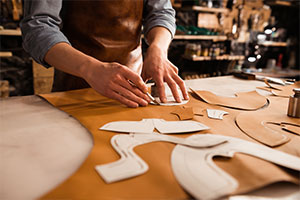Finding the perfect handbag that combines style, durability, and ethical production can be challenging. Traditional leather, while beautiful, often comes with environmental and moral concerns. Luckily, vegan leather provides a sustainable alternative that doesn’t sacrifice quality or looks.
Vegan leather is a synthetic alternative to genuine leather. It is lighter and more flexible than authentic leather. It can be produced in any color or texture, making it perfect for fashion items like purses. Additionally, it is better for the environment and does not harm animals. By choosing vegan leather, you are not supporting the animal product industry.
Let’s explore the specifics of vegan leather and why it might be the perfect material for your next handbag.
Why Choose Plant-Based Leather for Making Handbags?
There are a few benefits to using vegan leather, especially plant-based leather, such as:
- Better for the Earth: Plant-based leathers are sustainable and environmentally friendly.
- Cheaper: Usually, vegan leather is more affordable to produce than genuine leather.
- Lasts Just as Long: Plant-based leather can last just as long as animal-based leather.
- Predictability: Vegan leather lacks imperfections like scars or bug bites, leading to a more predictable cutting yield.

Why People Like Environmentally-Friendly Products?
One of the reasons people like vegan leather is because it’s better for the environment.
Animal agriculture is a leading cause of global warming, and traditional leather production involves a lot of chemicals.
On the other hand, vegan leather made from plants can be more sustainable and produce fewer emissions.
A recent report from First Insight and the Baker Retailing Center at the Wharton School of the University of Pennsylvania found that consumers of all ages, from Gen Z to Baby Boomers, are willing to spend more money on sustainable products.
90% of Gen X consumers will pay at least 10% more for sustainable products.
The top three reasons people buy sustainable products are to help the environment (30%), reduce waste during production (23%), and reduce their carbon footprint (22%).
Top brands like Patagonia and Native Shoes are all about being green.
According to a market report from Grandview Research, the green technology and sustainability market was worth more than $15.85 billion in 2022 and is expected to grow 22.4% through 2030.

Comparing the Costs: Plant-Based Leather vs. Traditional Leather
Plant-based leather is typically more affordable than traditional leather.
For instance, pineapple leather, such as Piñatex, uses waste parts of the pineapple plant, making it cost-effective and beneficial to farmers.
Significant brands like Adidas and Gucci recognize the cost benefits of plant-based leather and are collaborating with leather manufacturers on new lines of mushroom leather.
Other brands are exploring alternatives, like cactus leather and apple peel leather.
Although mushroom leather is still developing, mass production is expected to make it more affordable.
Currently, mushroom fabric from Bolt Threads costs around $25 per square foot, comparable to premium calf leather.
Pineapple leather, however, is much more affordable. It costs approximately $65 for 20 square feet, compared to $150 for the same size cowhide.

Durability: Plant-Based Leather vs. Animal Leather
While traditional animal leather is renowned for its durability, plant-based leather is a strong competitor.
Animal leather can last for generations with proper care but is sensitive to temperature fluctuations and can show wear over time.
Plant-based leather, particularly Piñatex, is durable due to its high cellulose content and tensile strength.
Key Differences:
| Comparison | Animal Leather | Vegan Leather |
|---|---|---|
| Appearance | Visual Imperfections | Uniform Finishing |
| Durability | More durable in the long term | Less delicate in the short-term |
| Cleaning | Needs specialized cleaning care | It can be cleaned with a wide variety of alcohol-based products |
| Malleability | Stretches and Shrinks Naturally | It can be structurally damaged with too much form manipulation |
Due to its uniform finishing and easy cleaning, manufacturers of small goods will find plant-based leather suitable for handbags, wallets, and embellishments.
Is Vegan Leather Any Good?
Vegan leather, or faux leather, doesn’t use animal skins.
This makes it an excellent option for people who care about animals.
Ethically, vegan leather eliminates the need for animal farming and slaughter, which can be brutal and inhumane.
Environmentally, vegan leather uses fewer resources like water and energy than traditional leather.
However, you also have to be aware of the environmental impact of some of the synthetic materials used in vegan leathers, which can sometimes release harmful toxins and microplastics into the environment.

What’s Good and Bad About Plant Leather?
Plant leathers are made from pineapple leaves (Piñatex), cork, apple peels, and mushroom roots.
The big plus with plant leathers is that they biodegrade, meaning they break down naturally without leaving nasty stuff behind.
They’re great for the environment, helping to reduce waste and pollution.
But they can be hard to make in large quantities and are often more expensive than synthetic vegan or genuine leather.
Also, while plant leathers are tough, they may not be as long-lasting and wear-resistant as good animal leather, so they’re probably better for fashion items you don’t use daily.

What’s the Science Behind Vegan Leather?
The science behind vegan leather is super cool and combines the use of both synthetic and natural materials.
One promising alternative is bacterial cellulose, which is produced by bacteria and is solid and flexible.
Another excellent material is fungal mycelium, which is the root structure of mushrooms.
Mycelium can be grown into leather-like sheets, then tanned and treated like traditional leather.
These biological materials are super sustainable and require less environmental impact.
People are working on these materials to find sustainable alternatives to animal leather that can be made without the ethical and environmental problems of raising animals.

What’s a Fun Fact About Vegan Leather?
Vegan leather can be made from a variety of materials.
For example, Piñatex is made from the fibers of pineapple leaves, a byproduct of the pineapple industry.
This helps pineapple farmers earn extra money and reduces waste.
Cork leather, another popular vegan option, is harvested from the bark of cork oak trees, which grow back after they are harvested, making it a renewable resource.
Apple leather is made from the waste of the apple juice industry, and mushroom leather (also known as mycelium leather) is made from the root structure of fungi.
These materials give us eco-friendly alternatives to traditional leather, each with unique characteristics and uses.

Does Vegan Leather Last?
The longevity of vegan leather can vary depending on the materials and processes used.
High-quality vegan leather can be incredibly durable and resistant to wear and tear.
It’s often treated to be water-resistant and can withstand daily use, making it great for handbags and other fashion accessories.
While early versions of vegan leather were criticized for not lasting as long, technological advances have significantly improved the quality.
For example, polyurethane-based vegan leather is known for being durable and flexible.
However, choosing reputable brands that prioritize quality is essential to ensuring that your vegan leather products last as long as possible.

What Sucks About Vegan Leather?
Vegan leather is not perfect.
First, some types, particularly those made from polyvinyl chloride (PVC), are bad for the environment.
The production of PVC releases toxic dioxins into the atmosphere.
This happens during the manufacturing process and when you dispose of the material.
Second, some vegan leathers are not as breathable as genuine leather, which makes them uncomfortable for specific applications like clothing.
Third, lower-quality vegan leather can crack and peel over time, mainly if used often.
To avoid this problem, you have to buy good vegan leather products.

What’s the Difference Between Vegan Leather and Faux Leather?
Vegan and faux leather are often used interchangeably but have different meanings.
Vegan leather refers to alternatives free from animal products and marketed to people concerned about animals and the environment.
Faux leather, on the other hand, is a broader term that can include any leather-like material made from animal hides, whether or not it’s produced with sustainability in mind.
All vegan leather is faux, but not all are vegan or eco-friendly.
When shopping for vegan leather, look for certifications or brand statements that confirm the product’s ethical and environmental credentials.

Is Vegan Leather Good Quality?
Vegan leather has come a long way in recent years.
The good stuff looks and feels like genuine leather.
It’s hard to tell the difference.
It all depends on the materials and how it’s made.
For example, polyurethane (PU) leather is known for its durability and realistic appearance.
Some brands use synthetic materials and natural fibers to make the leather feel more real.
Another benefit of vegan leather is that it’s easier to take care of because it’s generally more water and stain-resistant than traditional leather.
When you’re shopping for vegan leather products, read the reviews and product details to ensure you’re getting the good stuff.
Choosing vegan leather for your handbags means choosing a sustainable, ethical, and stylish alternative to traditional leather.
With its numerous benefits and growing popularity, vegan leather is redefining fashion with a conscience.
Explore the range of vegan leather products available and choose one that aligns with your values.

